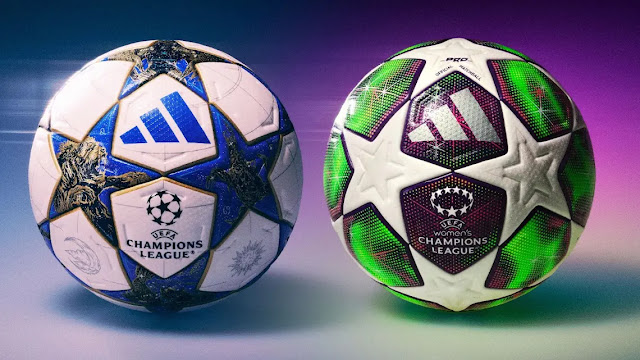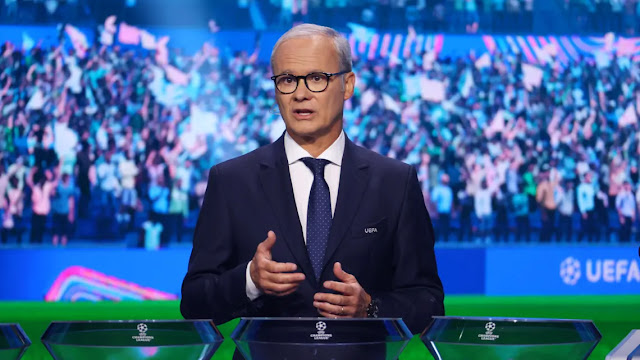In a dazzling display of innovation and artistry, Adidas has unveiled the official match balls for the league phase of the 2025/26 UEFA Champions League and UEFA Women’s Champions League, set to grace pitches across Europe starting August 27, 2025. These balls, inspired by the cosmos, pay homage to the stars of the game as they embark on their journey to the finals in Budapest, Hungary, and Oslo, Norway, in May 2026. The Champions League ball draws its aesthetic from the night sky, while the Women’s Champions League ball channels the ethereal beauty of deep space and the northern lights. Both designs encapsulate the grandeur of Europe’s premier club competitions while incorporating cutting-edge technology and sustainable materials, reflecting Adidas’ commitment to performance, creativity, and social responsibility.
This announcement comes as part of a broader narrative surrounding the 71st season of the UEFA Champions League, which kicked off on July 8, 2025, and will culminate in the final at Budapest’s Puskás Aréna on May 30, 2026. The Women’s Champions League, meanwhile, continues to elevate the profile of women’s football, with its final set to take place in Oslo. The introduction of these new match balls not only sets the stage for an exciting season but also underscores the growing synergy between football’s technical innovation and its cultural significance.
Design Inspiration: A Cosmic Tribute to Football’s Stars
The 2025/26 UEFA Champions League and Women’s Champions League match balls are more than just equipment; they are works of art that tell a story of ambition, destiny, and brilliance. Both balls feature the iconic UEFA Champions League star pattern, a symbol synonymous with the prestige and drama of these competitions. Embossed on a white base, the stars are elevated through unique celestial-inspired designs that capture the imagination and reflect the aspirations of the players and teams vying for glory.
UEFA Champions League Ball: The Night Sky
The UEFA Champions League ball draws its inspiration from the night sky, a fitting metaphor for a competition that showcases the brightest talents in club football. The design features stars outlined in gold and painted in blue, evoking the serene yet awe-inspiring beauty of a starry night. Hand-drawn zodiac signs in gold are intricately woven into the design, symbolizing heroic deeds and the notion of heavenly destiny. These elements resonate with the narrative of the Champions League, where players and teams strive to etch their names into footballing immortality, much like constellations in the night sky.
The aesthetic is both bold and elegant, balancing tradition with innovation. The gold and blue palette exudes sophistication, while the zodiac motifs add a layer of mystique, reminding fans and players alike of the epic battles that define the competition. Whether it’s a long-range strike soaring into the top corner or a perfectly weighted pass slicing through a defense, this ball is designed to be the centerpiece of unforgettable moments on the road to Budapest.
UEFA Women’s Champions League Ball: Deep Space and Northern Lights
The Women’s Champions League ball takes its inspiration from the vastness of deep space and the mesmerizing phenomenon of the northern lights, creating a design that is as dynamic as the competition itself. The ball’s hexagons, nestled between the white stars, are finished in a deep purple hue, overlaid with neon green gradients and flowing patterns inspired by the solar movement of the aurora borealis. Luminous pink and white stars punctuate the design, evoking the brilliance of celestial bodies in the cosmos and celebrating the rising stars of women’s football.
This vibrant and futuristic design captures the energy and innovation of the Women’s Champions League, a competition that continues to break barriers and inspire new generations of players and fans. The interplay of dark purple, neon green, and luminous pink creates a visually striking effect, ensuring that the ball stands out on the pitch while symbolizing the limitless potential of the women’s game. As teams compete for the title in Oslo, this ball will serve as a beacon of progress and excellence.
Shared Elements and Branding
Both balls prominently feature the Adidas Badge of Sport logo, alongside the respective UEFA Champions League and Women’s Champions League logos, anchoring their designs in the heritage of these competitions. The combination of celestial inspiration and iconic branding creates a cohesive narrative that honors the “stars” of the game—both the players who shine on the pitch and the fans who fuel the passion of the sport. These balls are not just tools of the trade but symbols of destiny, ambition, and the pursuit of greatness.
Technological Innovation: Pushing the Boundaries of Performance
Beyond their stunning aesthetics, the 2025/26 match balls incorporate a range of advanced technologies designed to enhance performance and elevate the game. Adidas has a long history of pushing the boundaries of football equipment, and these balls are no exception. Each element has been meticulously engineered to meet the demands of elite-level competition, ensuring precision, control, and consistency for players.
PRISMA Surface and Debossing Pattern
The balls feature an innovative PRISMA surface with a debossing pattern, which enhances precision and swerve. This textured surface allows players to impart greater spin and control on the ball, enabling pinpoint accuracy for free kicks, long passes, and curling shots. The debossing pattern is not just a design flourish but a functional feature that improves aerodynamics, ensuring the ball travels true through the air.
Outer Texture Coating and Seamless Construction
An outer texture coating provides a secure grip and complete control, allowing players to manipulate the ball with confidence in all conditions. Whether it’s a rain-soaked pitch or a dry summer evening, the coating ensures consistent performance. The thermally bonded seamless construction further enhances the ball’s durability and responsiveness, eliminating the inconsistencies associated with traditional stitched designs. This seamless construction is built for ultimate performance, allowing players to focus on their craft without worrying about equipment limitations.
CTR-CORE Technology
At the heart of both balls lies the groundbreaking CTR-CORE, a technological marvel designed for accuracy and consistency. The core consists of two components: a zero-waste bladder made from renewable, natural rubber and a carcass constructed from double-patched PES fabric, which provides strength and shape retention. This innovative core ensures maximum air retention and shape stability, supporting fast, precise play even in the most intense moments of a match. The CTR-CORE is a testament to Adidas’ commitment to blending performance with sustainability, as it minimizes waste while delivering top-tier functionality.
Sustainability: A Step Toward a Greener Future
In line with global efforts to address environmental challenges, the 2025/26 UEFA Champions League and Women’s Champions League balls are the most sustainable match balls in the competitions’ history. Adidas has incorporated a range of bio-based materials, including corn fibers, sugar cane, wood pulp, and rubber, into every layer of the ball without compromising performance. Additionally, the balls use recycled polyester and water-based ink, further reducing their environmental footprint.
This focus on sustainability reflects Adidas’ broader commitment to responsible manufacturing and environmental stewardship. By integrating bio-based materials and minimizing waste, the company is setting a new standard for sports equipment, proving that high performance and sustainability can go hand in hand. The zero-waste bladder in the CTR-CORE, for example, is a significant step forward, ensuring that the production process aligns with the principles of a circular economy.
Moreover, Adidas’ ongoing partnership with Common Goal amplifies the social impact of these balls. One percent of global net sales from Adidas footballs, including the 2025/26 Champions League and Women’s Champions League balls, will contribute to initiatives driving lasting social change in underserved communities. Through Common Goal, Adidas is helping to create a more inclusive future through football, supporting programs that empower young people, promote gender equality, and foster community development. This partnership underscores the transformative power of sport and Adidas’ role as a leader in driving positive change.
The 2025/26 UEFA Champions League: A Season of Stars
The unveiling of the new match balls coincides with the launch of the 2025/26 UEFA Champions League season, the 71st edition of Europe’s premier club competition and the 34th since it was rebranded from the European Cup to the Champions League. The season began with qualifying rounds on July 8, 2025, and will culminate in the final at Budapest’s Puskás Aréna on May 30, 2026. This season introduces the new league phase format, which was implemented in the 2024/25 season, replacing the traditional group stage with a single league of 36 teams, each playing eight matches against different opponents.
Teams in the League Phase
The league phase features a diverse and competitive field of 36 clubs from across Europe, including powerhouses from England, Spain, Italy, Germany, and France, as well as emerging teams from smaller footballing nations. The provisional list of qualified teams includes:
England: Liverpool, Arsenal, Manchester City, Chelsea, Tottenham, Newcastle
Spain: Barcelona, Real Madrid, Atlético de Madrid, Athletic Club, Villarreal
Italy: Napoli, Inter, Atalanta, Juventus
Germany: Bayern München, Bayer Leverkusen, Eintracht Frankfurt, Borussia Dortmund
France: Paris Saint-Germain, Marseille, Monaco
Netherlands: PSV, Ajax
Portugal: Benfica, Sporting CP
Belgium: Club Brugge, Union Saint-Gilloise
Türkiye: Galatasaray
Czechia: Slavia Praha
Greece: Olympiacos
Denmark: Copenhagen
Norway: Bodø/Glimt
Cyprus: Pafos
Kazakhstan: Kairat Almaty
Azerbaijan: Qarabağ
Twenty-nine teams qualified automatically through their domestic league performances or as holders of the Champions League (Paris Saint-Germain) or Europa League (Tottenham). Seven additional spots were determined through qualifying rounds, with play-off winners including Benfica, Club Brugge, Copenhagen, Bodø/Glimt, Pafos, Kairat Almaty, and Qarabağ. The inclusion of teams from nations like Kazakhstan and Cyprus highlights the Champions League’s growing inclusivity, offering opportunities for smaller clubs to compete on Europe’s biggest stage.
Key Fixtures and Draws
The league phase draw, conducted on August 28, 2025, produced several marquee matchups that promise to captivate fans. Liverpool and Manchester City will face reigning European giants Real Madrid, with the latter hosting Xabi Alonso’s side at the Etihad Stadium and Liverpool welcoming them to Anfield. Paris Saint-Germain, the defending champions after their 5-0 victory over Inter Milan in the 2025 final, face a challenging slate of opponents, including Barcelona, Bayern Munich, Tottenham, Newcastle, Atalanta, Bayer Leverkusen, Sporting CP, and Athletic Bilbao.
Other notable fixtures include Barcelona’s visits to Chelsea and Newcastle, Arsenal’s clashes with Bayern Munich and Atlético de Madrid, and tournament newcomers Kairat Almaty facing Real Madrid and Arsenal. Pafos, another debutant, will host Bayern Munich and visit Chelsea, showcasing the competition’s ability to pit minnows against giants.
The league phase matches are scheduled as follows:
Matchday 1: September 16–18, 2025
Matchday 2: September 30–October 1, 2025
Matchday 3: October 21–22, 2025
Matchday 4: November 4–5, 2025
Matchday 5: November 25–26, 2025
Matchday 6: December 9–10, 2025
Matchday 7: January 20–21, 2026
Matchday 8: January 28, 2026
The top eight teams in the league phase will advance directly to the round of 16, while those finishing ninth to 24th will compete in the knockout phase play-offs on February 17–18 and 24–25, 2026. The knockout rounds will continue with the round of 16 on March 10–11 and 17–18, quarter-finals on April 7–8 and 14–15, and semi-finals on April 28–29 and May 5–6, leading to the final in Budapest.
The Road to Budapest and Oslo
The 2026 UEFA Champions League final will be held at the Puskás Aréna in Budapest, a 67,215-capacity stadium that previously hosted the 2023 Europa League final. This will mark the first time Hungary hosts the Champions League final, adding a historic milestone to the competition’s legacy. UEFA’s decision to move the kick-off time to 6:00 PM local time, announced on August 28, 2025, aims to enhance the fan experience by making day trips more feasible and reducing travel stress. “An earlier kick-off makes day trips more feasible, reduces travel stress, and allows fans to enjoy the occasion without worrying about late-night logistics,” said Ronan Evain, executive director of Football Supporters Europe.
The Women’s Champions League final, meanwhile, will take place in Oslo, Norway, a fitting destination for a ball inspired by the northern lights. The earlier kick-off time for the men’s final and the stunning design of both match balls signal UEFA’s commitment to creating memorable and accessible experiences for fans, players, and viewers worldwide.
Conclusion
The unveiling of the 2025/26 UEFA Champions League and Women’s Champions League match balls by Adidas marks the beginning of an exciting new chapter in European football. With their celestial-inspired designs, cutting-edge technology, and sustainable materials, these balls embody the spirit of innovation and excellence that defines both competitions. As teams battle their way through the league phase and beyond, the balls will serve as a constant reminder of the stars—both on the pitch and in the sky—who inspire fans and players alike.
From the night sky of Budapest to the northern lights of Oslo, the 2025/26 season promises to be a cosmic journey filled with drama, passion, and unforgettable moments. Whether it’s a long-range screamer, a delicate chip, or a match-winning save, the Adidas match balls will be at the heart of the action, propelling the stars of the game toward their destiny in May 2026.





